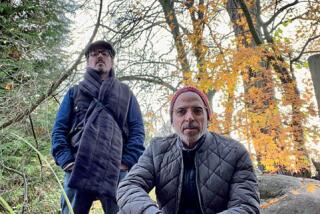From the archives: Ravi Shankar a commanding presence
On Sept. 28, 2011, Ravi Shankar was 91 and frail when he took the stage for an unforgettable night in Los Angeles. With Shankar’s death at 92 on Tuesday, we share the review of that performance from Times music critic Mark Swed.
I come to praise a legend. Ravi Shankar appeared at Walt Disney Concert Hall on Thursday night.
Legendary and iconic are terms cheapened and debased by advertising and the overeager. They should be reserved for someone like Shankar. I am among the maybe millions whose first meaningful experience with music from a distant culture was Shankar’s sitar playing. He opened ears and remade sensibilities.
He’s now 91. He canceled his appearance at Disney last fall because of illness and then canceled the rescheduled concert when Indian members of his ensemble couldn’t get visas in time. Last time I saw him, a few years ago, he seemed to be getting frail. Some, I know, bought tickets to the sold-out Disney show expecting a diminished player but thinking this would be a last chance to be in the presence of a master.
PHOTOS: Ravi Shankar | 1920 - 2010
Shankar is thin and walks with a cane. He has a striking new white beard which gives him the look of a sage. “I hope you recognize me,” he said in his welcoming remarks to the audience, “because I’ve gained weight.” Laughing, he pointed to the billowing muff under his chin.
But frail? Hardly. Shankar commanded the stage for 90 unforgettable, mood-elevating minutes. Once a showman, always a showman. Once an incomparable virtuoso sitar player, still –- I’m thrilled, and flabbergasted, to report -- a virtuoso.
Originally his daughter, Anoushka Shankar, a sitar star in her own right, was to have joined him, but she is a new mother and remained home in London. His respectful ensemble consisted of two impressive tabla players (Tanmoy Bose and Samir Chatterjee), a restrained second sitar (Parimal Sadaphal), a lovely echoing flute (Ravichandra Kulur) and two performers in the background providing the drone.
No one should hold it against Shankar for needing time to warm up. Surely, his fingers aren’t as nimble as they were in his heyday, which was quite a heyday. As a young musician, he was a dazzling dancer as well as dazzling sitarist. He composed the music for dances, created the choreography and danced them. He was compared to a god.
Concerts in India typically begin slowly, just as ragas themselves do. A player introduces the notes of the raga’s scale and gradually brings in the melody through a kind of timbral and harmonic haze. This could be compared to a cloud taking shape but always changing. The second section is rhythmic, and it becomes increasingly dynamic, typically ending in a wildly entertaining dialogue between the sitar and the tabla, which are tuned Indian drums.
PHOTOS: Arts & culture covered by Times photographers
After the ruminative opening evening raga, Shankar played a longer, sprightlier one with a snappy 16-beat structure. He took a brief break to feature his tabla players. But it wasn’t really a break, because he sat on his platform, beating out the rhythmic cycles with his hands and egging on the players. He regularly burst out into big smiles.
In fact, all evening Shankar seemed in warm, high spirits. In slow sections he became as if transported. When in quick sections he tossed off terse phrases, echoed by his ensemble, his mouth was agape as if to say, this old guy can still show you a thing or two.
Shankar has always been an innovator. He is a devout traditionalist, as all great Indian musicians must be. But he is also a modern man. His celebrity, of course, was Beatles-driven, and I hope that Martin Scorsese’s upcoming documentary on George Harrison gives the quiet Beatle’s devotion to Shankar full due.
But that’s only a small part of the Shankar legacy. He collaborated with the renowned classical violinist Yehudi Menuhin, who once compared the sitarist’s genius to Mozart’s. Shankar wrote two concertos for sitar and orchestra, premiered by two former Los Angeles Philharmonic music directors, Zubin Mehta and André Previn (though not, alas, by the L.A. Phil). He inspired student Philip Glass to become the Minimalist we now know. If he had done nothing more than compose the film scores for Satyajit Ray’s “Apu” trilogy in the 1950s, the name of Ravi Shankar would be remembered and revered.
Shankar introduced his third raga by saying he would show us something new. He muted the strings of his sitar with a cloth and turned it into an intriguing percussion instrument.
His final raga was a glittering garland of ragas, lasting 32 minutes, and full of spirit. No slowly getting into the lively swim of things here. Shankar jumped right in, kicking his feet as he played sprightly melodies and rhythms. He looked, with excellent reason, utterly delighted. Shankar’s cute, small white dog, Suki, was apparently delighted as well. It accompanies the sitarist everywhere and suddenly came running on stage, frolicking during the bows.
The Oxford English Dictionary defines legend first as “the story of the life of a saint.” Music may not have, precisely, saints. But no musician alive is a closer fit.
ALSO:
Charles Rosen dies at 85; pianist wrote ‘The Classical Style’
Al Pacino in ‘Glengarry Glen Ross’: What did the critics think?
Zubin Mehta’s heady days as Los Angeles Philharmonic music director
MORE
INTERACTIVE: Christopher Hawthorne’s On the Boulevards
TIMELINE: John Cage’s Los Angeles
PHOTOS: Arts and culture in pictures
More to Read
The biggest entertainment stories
Get our big stories about Hollywood, film, television, music, arts, culture and more right in your inbox as soon as they publish.
You may occasionally receive promotional content from the Los Angeles Times.











